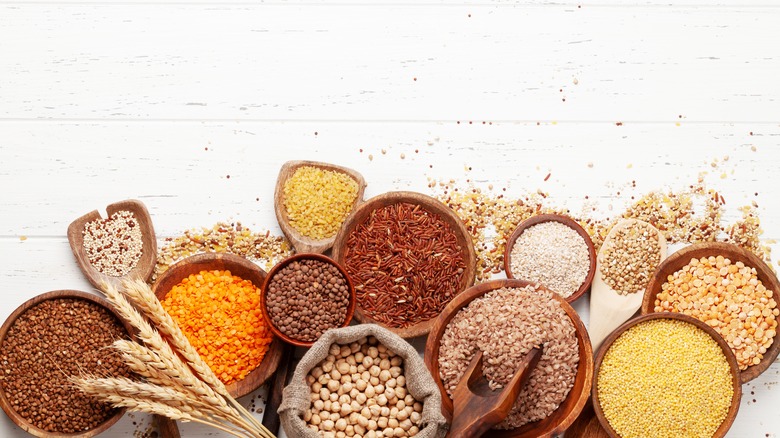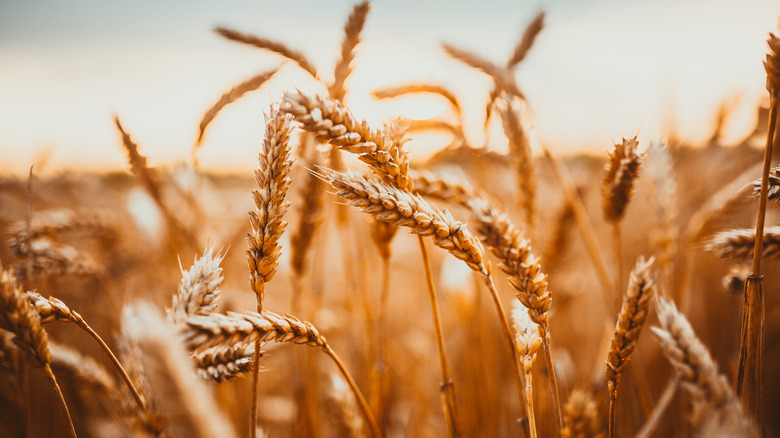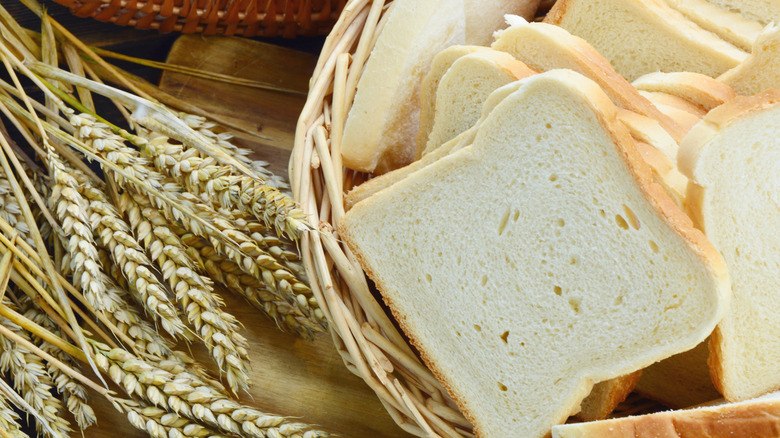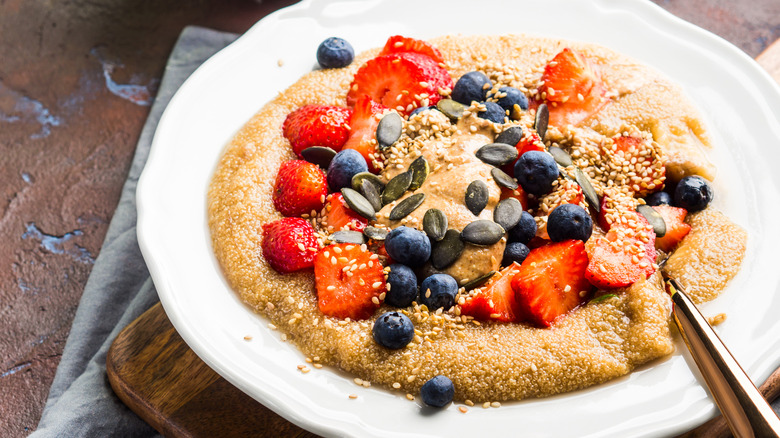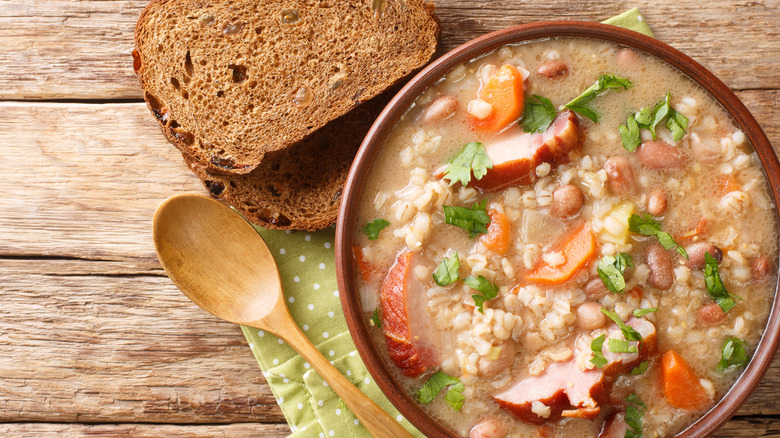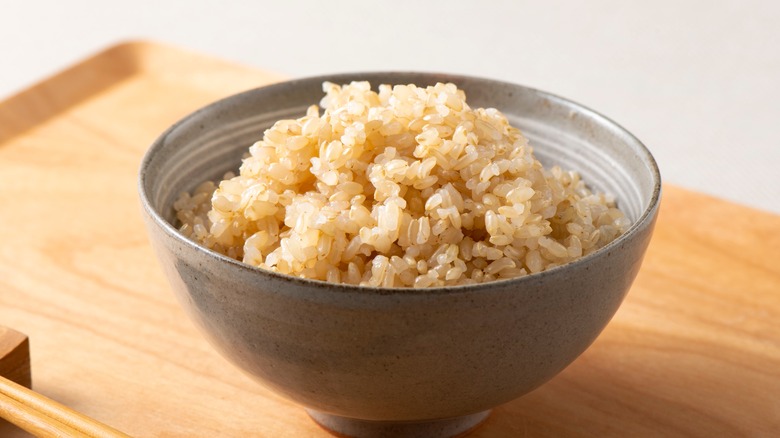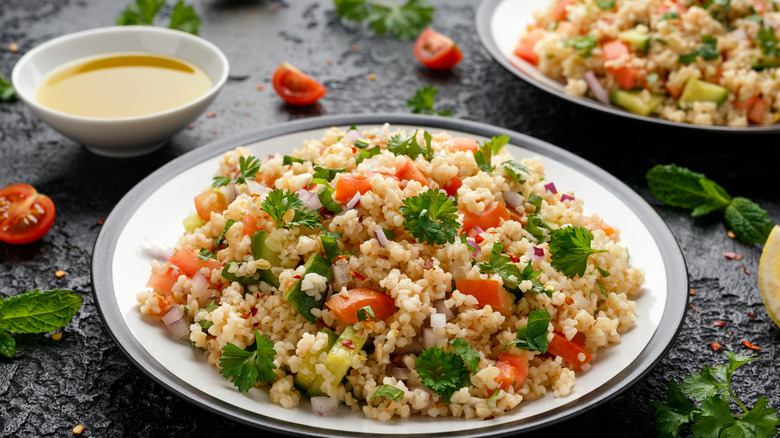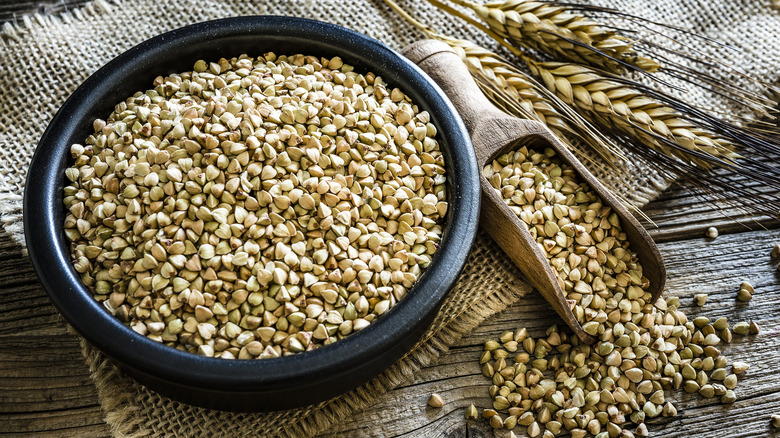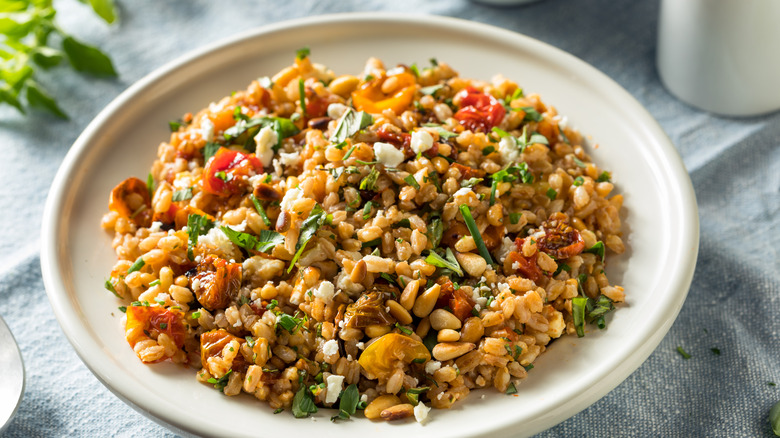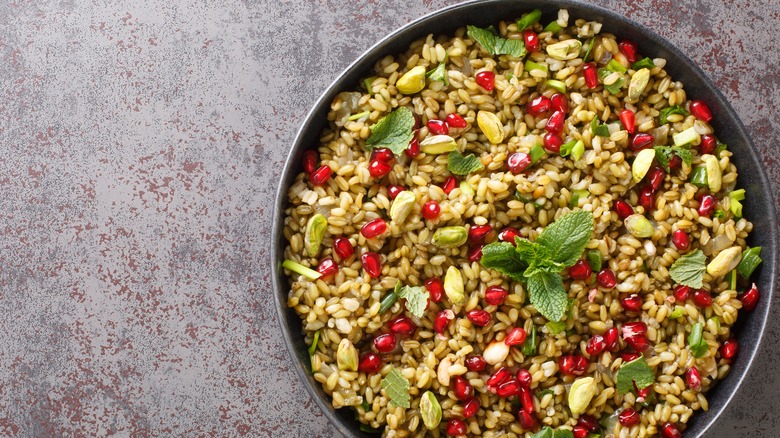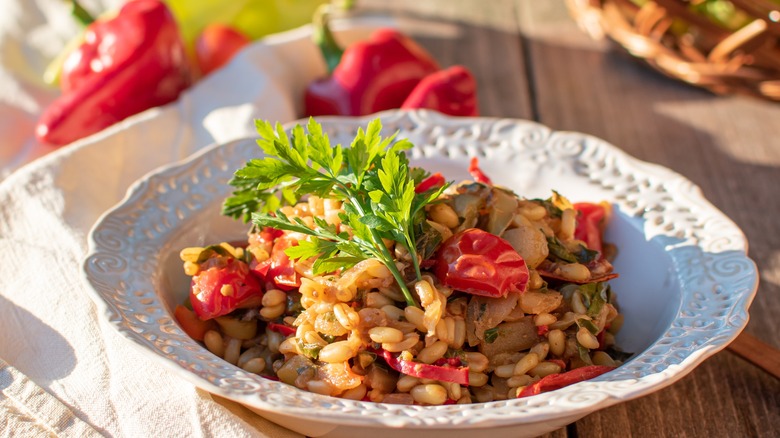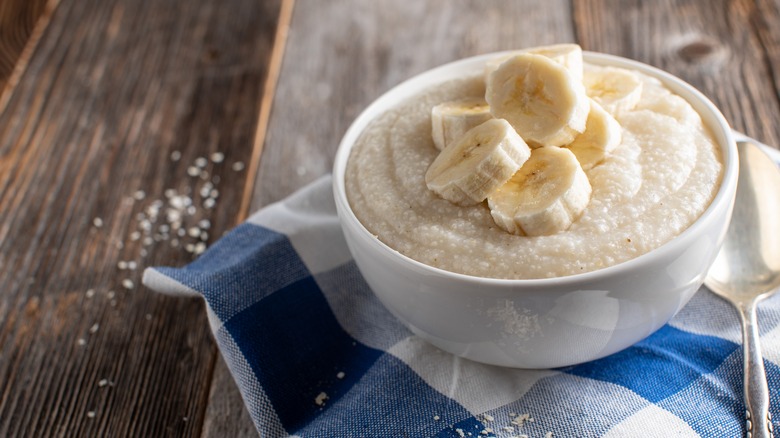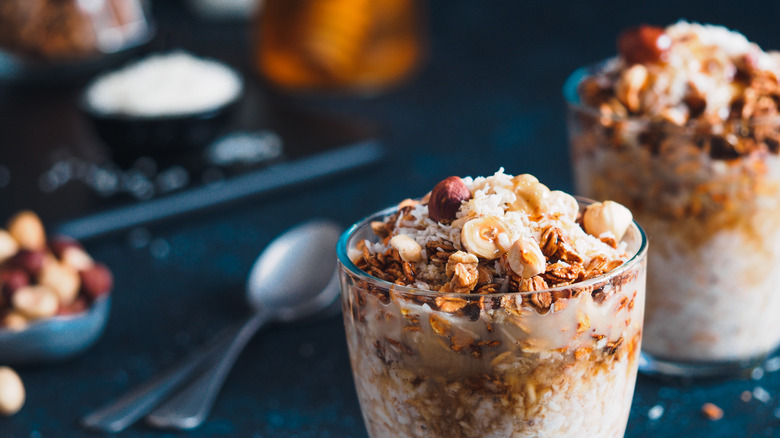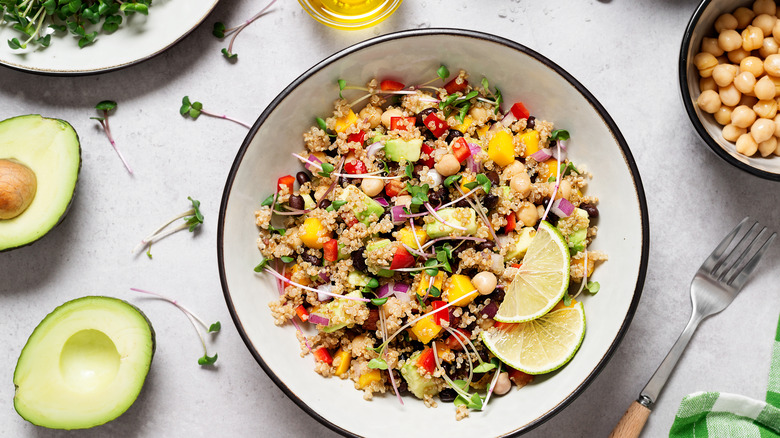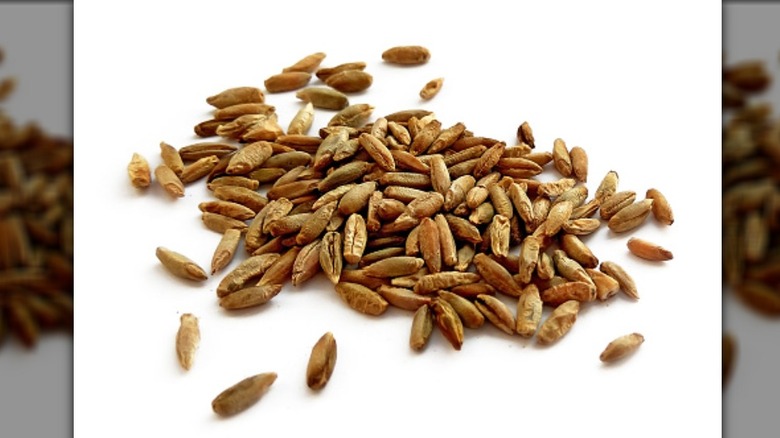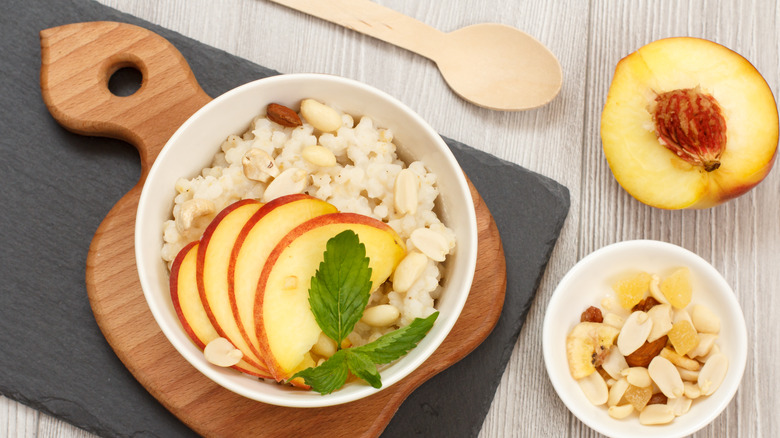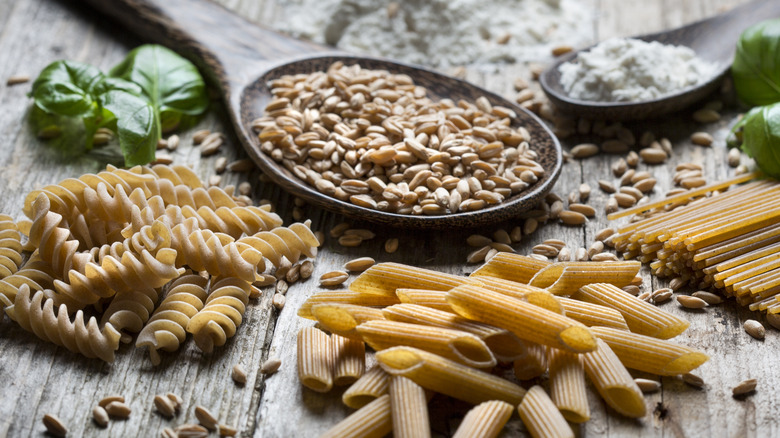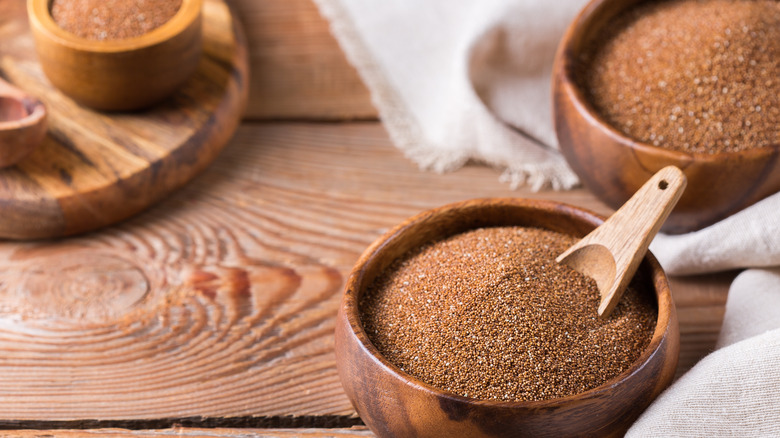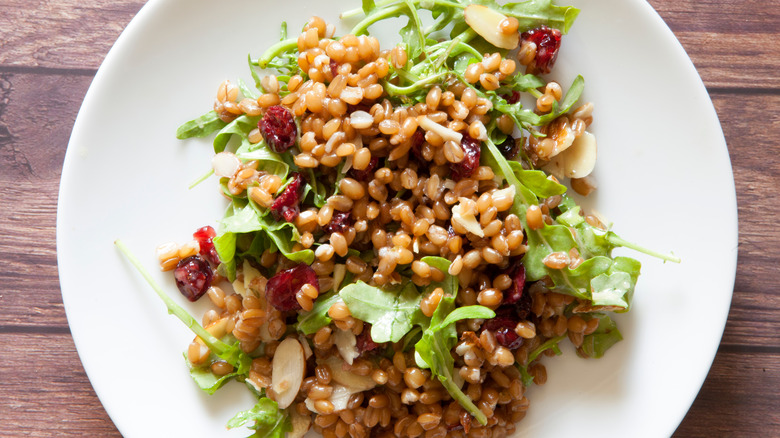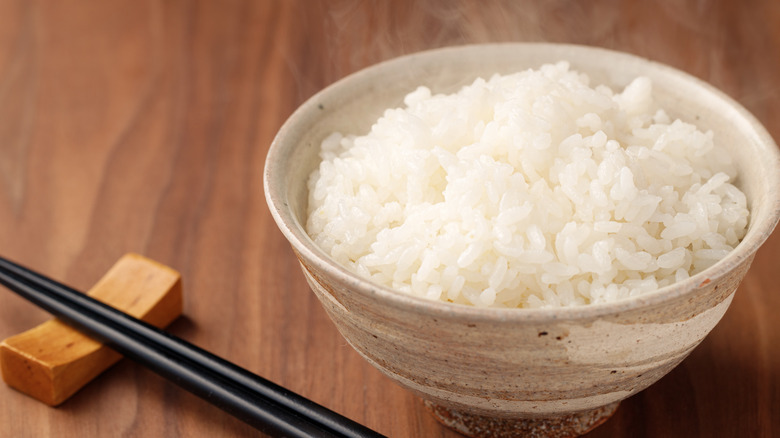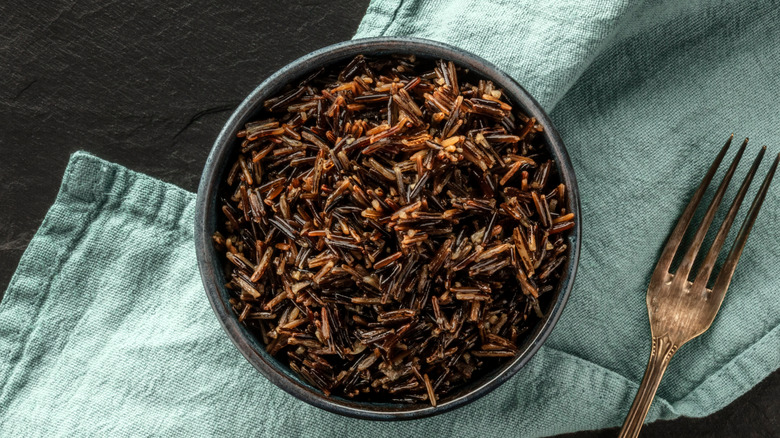19 Types Of Popular Grains And How To Use Them
Grains can be found on nearly every corner of the globe. Cuisines from around the world typically have a grain historically associated with their food culture. Yet, in our globalized food system, we now have access to more foods than ever, and grains are no exception. A whole assortment of grains can be found at your local supermarket, and others can easily be bought online and delivered to your home. You have endless possibilities at your disposal. Plus, diversifying grain crops by including more ancient grains like millet and sorghum may help reduce food shortages and, in turn, alleviate some pressure on global hunger.
If you want to try some new grains but don't know much about their applications (or even how to prepare them), this guide is for you. Here we explain how to use different types of popular grains, from ever-abundant rice to lesser-known crops like Kamut. In no time, you'll be expanding your palate and exploring the wide world of grains.
What are grains?
Grains, interchangeably called cereals, are the seeds of certain grasses cultivated for food. Across the globe, grains of all types are staple food crops that are critical in the diets of many people. Whether used as whole grains, milled into flour, or simply processed to improve either nutritional content or digestibility, these small powerhouses are packed with vitamins, minerals, and protein, making their way into every cuisine.
The most common form of grain is a dry grain, but fresh grains are also seasonally available. Choosing fresh or dried depends on many factors. Fresh grains are higher in water, with a slightly diluted nutritional content. Drying preserves the grain and gives it higher nutrient density.
Fresh grains have a shorter shelf life, which means they don't travel well and spoil easily. Dried grains are better for long-term storage, retaining their quality even when stored properly for years. Some fresh grains, like sweet corn, have specific culinary applications that are difficult to replicate in dried or processed forms. Although dried grains can be rehydrated for use, they will not have the same taste and texture as their fresh counterparts. Some fresh grains are easier to digest than dried ones. But dried whole grains can be made more digestible by soaking, sprouting, or cooking.
The difference between whole grains and refined grains
Whole grains have three parts. The bran is the outer protective layer of the grain, rich in fiber, B vitamins, and trace minerals. The next layer is the endosperm. This makes up the bulk of the grain and contains its starches, proteins, and some vitamins and minerals. The center embryo of the grain is the germ. This part of the grain has plenty of essential fatty acids and vitamins.
Whole grains keep all three layers intact. Because nothing is removed, whole grains retain all of their health benefits. They are rich in fiber, protein, antioxidants, minerals, and healthy fats. and can battle against certain cancers, type 2 diabetes, and heart disease, per Harvard School of Public Health. With a fiber content, whole grains may be easier to digest.
Refined grains are processed to remove the outer and innermost layers, leaving only the endosperm. This removes much of the fiber and many essential vitamins and minerals. Examples of products containing this type of grain include white rice, white bread, and other commercially produced pastries.
Fortified grains are another type of processed grain where specific nutrients are added to increase the nutritional value. In some cases, these nutrients were not present in the first place, but in others, processing stripped them from the whole grain.
Amaranth
Despite being an ancient grain, amaranth only became fashionable in the U.S. in the 1970s. Amaranth is a genus that contains up to 70 plant species, although only about 12 are cultivated by humans. Archaeologists date the origin of this grain as far back as 8,000 years ago in northern Argentina, with domestication beginning about 6,000 years ago.
Amaranth has a sweet and nutty flavor with a grassy aroma. This gluten-free grain is popular in soups and chili or cooked down to a porridge-like cereal. For a pilaf-style grain, use 1 ½ cups of water per 1 cup of amaranth or 2 ½ cups of water for cereal-style.
Similar in size and cooking time, amaranth is a good quinoa substitute. Just keep in mind that amaranth has a much stronger taste than quinoa. It's also recommended to sprout this grain before cooking to aid with digestion.
Barley
Another ancient crop, barley is one of the top-produced grains globally. According to Statista, 147.05 million metric tons were produced in the 2021/2022 crop year, although a large chunk of this is used for beer production. A member of the Poaceae family, barley is just about as old as time. The type of barley we consume today was first developed from the wild variety Hordeum spontaneum over 10,000 years ago.
Most people are familiar with the classic beef barley soup, but what else can you do with this abundant grain? Barley has a subtle nutty flavor, making it versatile for meal planning, and its slightly chewy texture makes it very comparable to brown rice or farro. In addition to soups and stews, barley makes a great hot cereal or pairs well with roasted vegetables.
Whether you choose whole grain hulled or refined pearl barley, you can cook it similar to rice using the absorption method at a ratio of 3:1. Hulled barley, which has been minimally processed to remove the inedible outer hull, can take up to an hour to cook. Pearled barley, which also has the bran removed and polished down, is quicker cooking, taking about 40 minutes.
Brown rice
Brown rice differs from white varieties in that it contains all three parts of the grain: the germ, bran, and endosperm. You can use brown rice in most situations that call for white rice, from fried rice to rice bowls, but remember that brown rice does have a chewier texture.
Because brown rice contains bran, it has higher fiber content and a slower cooking time than white rice. One reason is that it absorbs more water. Use a ratio of 2:1 when cooking brown rice. You can expect short-grain brown rice to take up to 75 minutes to cook, while long and medium grains will take about 30 minutes.
Brown rice has been touted for its health benefits. Compared to white rice, it's higher in nutrients, which are stored mainly in the bran. It is a good source of magnesium, which has been shown to help control blood sugar levels.
Bulgur
A staple in Middle Eastern cuisines, bulgur is a whole wheat grain often compared to couscous. Unlike couscous, bulgur is often sold parboiled and only takes about 12 minutes of simmering to cook. However, bulgur doesn't even need cooking over direct heat. Pour 3 cups of boiling water over 1 cup of bulgur, and the grain will absorb all the water after about 20 minutes.
One of the most common uses for bulgur is tabbouleh, a bright, citrusy Levantine grain salad packed with a rich herbaceous flavor. But tabbouleh isn't the only application for bulgur; you can also use it for other grain salads and pilaf-style dishes. Given its history, it is not surprising that bulgur is so popular in Middle Eastern countries. In fact, bulgur production is a 4,000-year-old tradition in the region, with mentions of the grain appearing in the New Testament of the Bible.
Buckwheat
In an unusual culinary twist, buckwheat is neither related to wheat nor technically a cereal grain. It belongs to a group known as pseudocereals which are eaten in the same way as cereals but not cultivated on grasses.
Buckwheat has a strong, nutty taste with a distinctive sharp undertone that is astringent and almost bitter. Some people find it too strong a flavor to be used on its own. In this case, combining it with other types of flour can lighten up the texture and also relieve some of the sharp flavor. Dark buckwheat tends to be stronger in flavor than light, too.
Buckwheat is a good source of protein and is rich in complex carbohydrates. It is a complete protein with all eight essential amino acids. Additionally, buckwheat is high in dietary fiber, magnesium, copper, and phosphorus. Enjoy buckwheat as a flour, used to bake pancakes, muffins, or bread. Traditional Russian blini and Japanese soba noodles use buckwheat. Buckwheat groats are cooked in the same manner as rice and quinoa. These make a filling addition to salad and soup but can also be turned into a savory side dish.
Cornmeal (grits and polenta)
Indigenous to North America, corn is ubiquitous in the American food scene. In 2021, the U.S. produced 15.1 billion bushels, the second-highest crop year on record (via USDA). Made by grinding the dried grain, cornmeal is a readily available processed ingredient. Finely ground cornmeal is used like flour for items like cornbread and spoonbread, but as a cooked grain, you are probably more familiar with its alter-egos: grits and polenta.
Grits are very coarse stone-ground cornmeal. Derived from hominy, grits come in both white and yellow corn. This classic Southern American dish is often served as a creamy porridge that can be savory or sweet. While some chefs recommend soaking grits overnight, they still need a 4:1 ratio and at least an hour of cooking to get the proper consistency.
The Italian take on grits, polenta is a dish that is growing in popularity in the U.S. Made from stone-ground yellow cornmeal, polenta does not need pre-soaking and depending on the application, recipes call for a 4:1 or 5:1 ratio. For firmer polenta that will be fried up as little cakes, use 4 cups of liquid. For creamy polenta, you'll need that extra cup of liquid. Polenta takes about 45 minutes to cook. In Italian cuisine, polenta is often used as a base for hearty foods like ragù or beef stew.
Farro
Despite having a close association with Italian cuisine, farro is an ancient grain with Middle Eastern origins. Brought to Italy by the Romans, this grain has been a staple in the Italian peninsula for centuries. Today farro is made from three different grains: farro piccolo (einkorn), farro medio (emmer), and farro grande (spelt). The emmer variety is the one most common in the U.S.
There is no one set way to cook farro. Some will cook it using the absorption method at roughly a 3:1 ratio, but others cook it in a big pot of water, like pasta, until it is tender. The cooking time will depend on the level of processing of the grain. Pearled (hull and bran removed) takes 15-20 minutes, while semi-pearled (hull and some bran polished off) takes 20-30 minutes. Whole farro can take up to 40 minutes to fully cook.
Farro has a chewy quality, but it can turn to mush when overcooked. Most people aim for an al-dente texture. Farro is frequently used in grain salads, like this farro verde with feta and olives. It can also be turned into a risotto-style dish known as farrotto.
Freekeh
Another ancient crop finding a place on the modern table is Freekeh, a roasted or smoked young green durum wheat with the outer hull removed. Often labeled a superfood, it has 5 grams of protein and 4.5 grams of fiber per serving and is a good source of nutrients, including manganese, phosphorus, magnesium, and zinc.
Like many foods, there is folklore attached to this grain. According to the tale, in 2,300 B.C., an ancient Middle-Eastern city fearing an attack and starvation, decided to pick the young green heads of their wheat. When the city was set on fire, the green wheat burned and left them with an edible grain. Today that smoky, nutty grain is enjoyed in salads, especially with Middle Eastern flavors, such as a tahini-lemon dressing. Cook freekeh using the pasta method, boiling it in a pot of water for about 20 minutes or until tender.
Kamut
Given this grain's nutritional value, it is surprising that more people aren't singing the praises of the Kamut. One of the lesser-known grains, Kamut (also known as Khorasan wheat), has origins in the Fertile Crescent region in the Middle East. Its name comes from the Khorasan province of Northeast Iran. In the late 20th century, this grain came onto the national scene when farmers started growing it in Montana.
A quinoa substitute (although not gluten-free), Kamut is a protein-rich grain. A cup of cooked Kamut contains 7.4 grams of fiber and a whopping 9.8 grams of protein. It's also packed full of nutrients like zinc, phosphorus, magnesium, and niacin. Boiled using the pasta method, Kamut can take up to an hour to cook. Very similar in texture to wheat berries, this nutty-tasting grain is great in salads or pilaf-style dishes.
Millet
By many reports, millet was first cultivated in Northern China about 7,500 years ago. Millets are grain seeds that look very much like seeds but function like whole grains. Similarly to amaranth, millets refer to about 50 different grass species. One example is fonio, which essentially is a tiny version of millet commonly consumed in several African nations.
Because of its size, millet cooks fairly quickly, but it's also easy to botch. Using too little or too much water will ruin your millet. The ideal ratio is 2:1, although you may need less water if you pre-soak this grain. It will take about 20 minutes of simmering to cook.
Millet should be light and fluffy, similar to couscous or bulgur. It has a nutty flavor with a subtle sweetness and is a popular choice for people following a gluten-free diet. The cooked grain can be turned into little savory gluten-free millet fritters with herbs, raisins, spinach, and feta.
Oats
Oatmeal is a grain cereal that has had a reputation for being boring, at least until the concept of overnight oats became trendy. Another member of the Poaceae family, oats are the seeds of oat grass. There are three types of oats that are readily available in the market: instant, rolled, and steel-cut. Each variety starts out as groats, which are whole unbroken grains, but the difference is in how they are processed.
The most processed variety is instant (like those packets of instant oatmeal you can heat up in the microwave). These oats are pre-cooked, dried, rolled, and pressed into thin flakes. This process is why they cook so quickly, in as little as 30 to 90 seconds.
Rolled oats, also called old-fashioned oats, are not pre-cooked but steamed and pressed. They take slightly longer to cook (about 5 to 10 minutes) but are ideal for overnight oats since they won't completely turn to mush like the instant ones.
Probably the most misunderstood, steel-cut oats are groats cut down into smaller pieces that look like broken corn kernels. They take the longest to cook (about 20 to 30 minutes). Steel-cut oats can be used for overnight oats, but the texture tends to be denser and chewier.
Quinoa
Hailed as a superfood and an American obsession in recent decades, quinoa is technically not a grain. Quinoa is the seed of the goosefoot plant, part of the Amaranthaceae family, making it closely related to beets, spinach, and chard. However, it acts more like a grain, so it is often lumped into this category. A one-cup serving of quinoa contains 8 grams of protein and 5 grams of fiber in addition to providing a good source of manganese, phosphorus, magnesium, folate, and thiamin.
Quinoa's production dates back to the Inca Empire. It has been cultivated for over 5,000 years in the Andean region of South America, which includes Peru, Bolivia, Ecuador, and Chile. Today, quinoa is grown in various regions of the world, including the U.S., but the highest concentration still comes from its indigenous region.
These small seeds come in multiple colors, but it is most commonly seen on the shelves in the pale yellow form. Quinoa has a natural coating called saponin, which has a bitter taste. Those complaining of its astringent taste would be better off rinsing quinoa before cooking. Using a ratio of 2:1, quinoa takes about 20 minutes to cook. It can be eaten on its own as a side dish, added to soups or salads, or in many situations where you might typically use other grains.
Rye
Rye is a cereal grain that is perhaps most well-known for its distinctive flavor in bread. It's a native crop of Turkey and closely related to both wheat and barley and has been cultivated since the Middle Ages. Rye is packed with soluble dietary fiber that can be beneficial for heart health. Some of its essential vitamins and minerals include B vitamins, magnesium, zinc, and iron. The high fiber content of rye can help with digestion and may also help to regulate blood sugar levels.
As noted above, one of the most common uses of rye is in bread. Rye bread ranges from light to dark and depends on how much rye is used in the recipe. Pumpernickel bread, for example, is the darkest version of rye bread made with whole grains. Flakes of rye can be used to make porridge, similar to oatmeal. They are also an excellent addition to homemade granola or muesli.
Whole rye berries can be cooked and served like rice. If you'd like to expand your pantry staples, dried rye berries can also be ground into flour. Use this flour to make rice crisps or crackers. Finally, if you're familiar with Sazerac cocktails, then you've probably heard of rye whiskey, a distillation of rye berries.
Sorghum
This ancient grain traces its origin to Africa over 4,000 years ago, but it has a strong association with Southern cuisine in the United States. Sorghum is believed to have been introduced to America via ships transporting enslaved Africans. Because of this, sorghum has strong roots in Southern African American food traditions. The green juice of the sorghum plant can be boiled into a syrup and used as a sweetener. While the little grain kernels can be popped over the stove like popcorn, sorghum is also great cooked like rice or in a salad.
This grain takes a long time to cook, but thanks to a pressure cooker, you can cut down on the cooking time. This Instant Pot sorghum uses a 3:1 ratio and cooks on high pressure for 30 minutes. On the stovetop, it would take about an hour of simmering. With a slightly chewy texture, sorghum would make a good substitute for farro or brown rice, whether consumed on its own as a side or added to a salad. It pairs well with warm flavors like ginger and cinnamon or ingredients like nuts and berries.
Spelt
Spelt is a nutty, sweet-tasting flour that has been cultivated for over 7,000 years. It is related to wheat and, as such, contains gluten. Even so, there are some people with non-celiac gluten sensitivity who have an easier time with spelt than with wheat flour.
Along with its other ancient grain brethren, spelt has a substantial amount of protein. It also contains magnesium, iron, and phosphorus, among other essential minerals. Just like rye and some other grains on this list, spelt contains high amounts of fiber that can help control blood sugar spikes and may have some nutritional benefits.
Spelt can be used as a one-to-one swap for wheat flour in many recipes, including decadent pasta and many types of bread. Spelt berries — whole spelt kernels — can be cooked as you would arborio rice into a creamy risotto. Add the berries to salads and soups, too. Spelt is also delicious at the breakfast table. Not only do spelt flakes make a delicious cereal on their own (or added into granola), but they can work with spelt flour in muffins, pancakes, and waffles to add nutrition and texture.
Teff
Another African grain, teff might be most known in its flour form, which is used to make the fermented, slightly sour Ethiopian flatbread injera. This grain was first cultivated in Ethiopia over 6,000 years ago and is still a constant in their cuisine. Now growing in popularity in the U.S., teff boasts a high nutritional value. It has 6.5 grams of protein and 4 grams of fiber in each ¾-cup serving and is high in calcium, magnesium, zinc, and manganese.
Whole teff resembles tiny dark seeds and can be cooked similarly to millet, but it takes a 3:1 ratio with 20 to 30 minutes of simmering. You can soak it overnight, but it is not necessary. Teff has a unique flavor — slightly sweet with notes of hazelnut, coffee, and molasses. Because of these flavor notes, it's excellent with warm flavors like cinnamon and ginger.
Wheat berries
Wheat kernels have three main parts (the bran, germ, and endosperm), which are surrounded by a husk called the hull. When that hull is removed, those wheat kernels are called wheat berries. A nutritional powerhouse, wheat berries have excellent health benefits because they contain the bran and germ, which hold most of a grain's nutrients. A 48-gram serving contains 9 grams of protein and 4 grams of fiber, and it's high in iron, zinc, vitamin B6, and magnesium.
While they are not berries, wheat berries go great with fruits like goji berries, such as in this ancient grain salad recipe. They also have a fun chewy texture, and their subtle nutty flavor makes this a versatile grain, pairing well with numerous flavors. Wheat berries are best cooked using the pasta method and will require about 30 minutes of simmering to reach the desired tenderness.
White rice
White rice is a general term for rice with the husk, bran, and germ removed. Many types of rice, from fragrant jasmine to basmati, have white versions. Culinarily speaking, white rice primarily refers to the varieties of rice commercially sold as medium and long grain white rice. While white rice may contain fewer nutrients than brown varieties, there are still some benefits of this type of grain. White rice cooks quicker than brown rice and is considered easier to digest. Also, many people simply prefer the taste of white rice over brown rice.
With its fairly neutral taste, white rice is a staple grain for everyday cooking. It is a popular side item to serve alongside stew-like dishes, such as curries, especially with jasmine and basmati varieties. Leftover white rice is also the go-to for making fried rice. Recipes generally call for 1 ½ to 2 cups of water per cup of rice but pay close attention to the type of rice you are cooking, as that may be too much. For instance, white rice varieties like jasmine rice only need 1 ¼ cup of water and about 15 to 20 minutes to cook.
Wild rice
Culinary names can often be confusing. Sweetbreads aren't sweet bread, and strawberries aren't even berries. Similarly, wild rice is not a member of the rice family. Instead, wild rice is the seed of an aquatic grass that is native to North America. Known as nanoomin in Ojibwe (an Algonquian language), this indigenous grain is popular in Native American cuisine and often served alongside other native foods, like corn, such as in this wild rice sauté.
Often with a dark color, wild rice is typically toasted before becoming commercially available, giving it a nice smoky flavor. It can be used in place of brown or white rice and is also commonly added to soups. At a 4:1 ratio, wild rice will be cooked after about 45 minutes.
Wild rice boasts high nutritional value. A 100-gram portion of cooked wild rice contains fewer calories (101) and carbohydrates (21.3 grams) and more protein (3.99 grams) and fiber (1.8 grams) than even brown rice. It also has 30 times more antioxidants than white rice, making this food a nutritional powerhouse.
